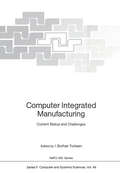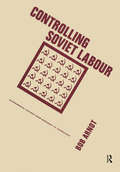- Table View
- List View
Comecon Data 1987 (Vienna Institute for Comparative Economic Studies)
by Vienna Institute for Comparative Economic StudiesThis is a statistical handbook of data about COMECON, the Council for Mutual Economic Assistance whose members include Bulgaria, CSSR, GDR, Hungary, Poland, Romania and the USSR. It includes details on population, trade, finance, energy, living standards and national product.
Comecon Foreign Trade Data 1986: (pdf) (Vienna Institute for Comparative Economic Studies)
by Vienna Institiute for Comparative Economic StudiesCommercial Law: Case Studies in a Business Context
by Desmond PainterThis pack of lecturer, photocopiable, material is designed to provide sets of authentic case studies to illustrate a variety of aspects of Company Business Law. It consists of a collection of 19 individual scenarios, each of which is introduced and has a variety of tasks attached.
Community Financing of Education: Issues & Policy Implications in Less Developed Countries (Comparative and International Education Series #Volume 5)
by M. Bray K. LillisThis volume discusses the issues relating to community support for education, a topic which has come increasingly to the fore in recent years, especially in the Third World. The book is divided into four main areas: Firstly, an initial explanation of the conceptual framework of the book is given. Secondly, the issues surrounding community financing of education are explored, including community bodies engaged in fund-raising, generating resources, school fees, geographic and social inequalities and central guidance and control. The third section discusses case studies from seven countries, and finally the policy implications of this study are assessed.
Company Law: Case Studies in a Business Context
by Desmond PainterA set of twenty problems in company law. The loose-leaf case study pages are licensed for bona fide lecturers to photocopy for assignment and seminar use. Full lecturers notes are provided showing how the cases can be fully updated in practical, activity-based study.
Comparative Technology Choice in Development: The Indian and Japanese Cotton Textile Industries (pdf)
by Gustav Ranis Keijiro Itsuka Michelle Stack Annette FörsterCompromise, Negotiation and Group Decision (Theory and Decision Library C #1)
by Bertrand Munier Melvin ShakunComputer-Aided Production Management (IFIP State-of-the-Art Reports)
by Asbjorn RolstadasThe purpose of this book is to discuss the state of the art and future trends in the field of computerized production management systems. It is composed of a number of independent papers, each presented in a chapter. Some of the widely recognized experts in the field around the world have been asked to contribute. lowe each of them my sincere gratitude for their kind cooperation. I am also grateful to Peter Falster and Jim Browne for their kind support in helping me to review topics to be covered and to select the authors. This book is a result of the professional work done in the International Federation of Information Processing Technical Committee IFIP TC5 "Com puter Applications in Technology" and especially in the Working Group WG5. 7 "Computer-Aided Production Management". This group was established in 1978 with the aim of promoting and encouraging the advancement of the field of computer systems for the production management of manufacturing, off shore, construction, electronic and similar and related industries. The scope of the work includes, but is not limited to, the following topics: 1) design and implementation of new production planning and control systems taking into account new technology and management philosophy; 2) CAPM in a CIM environment including interfaces to CAD and CAM; 3) project management and cost engineering; 4) knowledge engineering in CAPM; 5) CAPM for Flexible Manufacturing Systems (FMS) and Flexible Assembly Systems (F AS); 6) methods and concepts in CAPM; 7) economic and social implications of CAPM.
Computer-Aided Transit Scheduling: Proceedings of the Fourth International Workshop on Computer-Aided Scheduling of Public Transport (Lecture Notes in Economics and Mathematical Systems #308)
by Joachim R. Daduna Anthony WrenThis volume consists of papers presented at the Fourth International Workshop on Computer-Aided Scheduling of Public Transport, which was held in Hamburg from 28th to 31st July 1987. The first of this series of Workshops was held in Chicago in 1975. Papers presented then tended to look forward to what might be done in the future application of computers to problems in transit scheduling. No presentations described systems which had been implemented and were being used on a regular basis, although a few papers discussed apparently successful once-off applications in both bus scheduling and bus crew scheduling (or run-cutting). However, within a few months of the end of that first workshop some systems had been implemented, both in Europe and in North America. By the time of the second Workshop, in Leeds in 1980, several systems were in regular use. Most of the crew scheduling implementations were based on heuristic methods (e.g., RUCUS), although mathematically based methods were being used in Quebec City and in Hamburg, and several papers described further mathematical methods in the course of development. A wide variety of bus scheduling approaches was reported, many of them being in regular use.
Computer Integrated Manufacturing: Current Status and Challenges (NATO ASI Subseries F: #49)
by Kiyoji Asai Gunduz UlusoyThe Current state of expectations is that Computer Integrated Manufacturing (CIM) will ulti mately determine the industrial growth of world nations within the next few decades. Computer Aided Design (CAD), Computer Aided Manufacturing (CAM), Flexible Manufacturing Systems (FMS), Robotics together with Knowledge and Information Based Systems (KIBS) and Com munication Networks are expected to develop to a mature state to respond effectively to the managerial requirements of the factories of the future that are becoming highly integrated and complex. CIM represents a new production approach which will allow the factories to deliver a high variety of products at a low cost and with short production cycles. The new technologies for CIM are needed to develop manufacturing environments that are smarter, faster, close-cou pled, integrated, optimized, and flexible. Sophistication and a high degree of specialization in materials science, artificial intelligence, communications technology and knowledge-information science techniques are needed among others for the development of realizable and workable CIM systems that are capable of adjusting to volatile markets. CIM factories are to allow the production of a wide variety of similar products in small batches through standard but multi mission oriented designs that accommodate flexibility with specialized software.
Computer Integrated Manufacturing: Einsatz in der mittelständischen Wirtschaft Fachtagung, Saarbrücken, 24.–25. Februar 1988
by August-Wilhelm ScheerDie Entwicklung von CIM-Konzeptionen und ihre Realisierung ist z.Zt. vor allen Dingen eine Domäne der Großindustrie. Sie besitzt das notwendige Wissen und auch das erforderliche Kapital, um entsprechende zukunftsorientierte Konzepte der Informationsverarbeitung zu erarbeiten und in konkrete Hardware- und Sofwarelösungen umzusetzen. Um den Vorsprung in der Flexibilität, den die mittelständische Industrie heute noch hat, auch in Zukunft halten zu können, muß auch sie stärker den Gedanken der ganzheitlichen Bearbeitung von Vorgangsketten aufnehmen. Der gegenwärtige Rückstand der mittelständischen Industrie bei der CIM-Einführung ist auf mehrere Ursachen zurückzuführen. Zum einen ist es für mittelständische Unternehmen in der Regel zu kostenaufwendig, eigene CIM-Konzepte zu entwickeln, zum anderen werden komplette CIM-Lösungen für die mittelständische Wirtschaft von EDV-Herstellern bisher kaum angeboten. Vor allem aber fehlt den Mitarbeitern aus mittelständischen Beitrieben oftmals das für die CIM-Einführung fachliche Know-how. Während durch das Vordringen von Low-Cost-Systemen der Kapitalbedarf mittelfristig nicht Engpaß bleiben wird und auch das Angebot der Informationsanbieter zunehmen wird, bleibt das fachliche Know-how auf längere Zeit begrenzender Faktor. Hier genau setzt der vorliegende Band an. Von hochrangigen Wissenschaftlern und fortschrittlichen CIM-Anwendern wird ein Grundwissen über CIM vermittelt und Entwicklungstendenzen werden aufgezeigt. Die Anwender berichten über ihre Realisierungen in CIM-Teilkomponenten. Das Informationsangebot wird abgerundet durch die Darstellung von Softwarelösungen in CIM-Bereichen für die mittelständische Wirtschaft.
Computer und Beteiligung: Beiträge aus der empirischen Partizipationsforschung (Sozialverträgliche Technikgestaltung, Materialien und Berichte #2)
by Leo KisslerComputers, Jobs, and Skills: The Industrial Relations of Technological Change (Approaches to Information Technology)
by Christopher Baldry"Faith. Hope. and Charity and the greatest of these is Charity. " "Hardware. Software. and Lil'ell'are and the greatest of these is . . . " As information technology ceased to be the prerogative of computer scientists and electronics engineers, those of us from other disciplines had to contend with the jargon which was already in vogue. We learned to live with "hardware" and "software. " We were less enthusiastic about "Iiveware. " Polite and some impolite questioning revealed that "Iiveware" was a euphemism for "people. " We were not amused. As one spirited participant observed, "I refused to go home and tell my children that Almighty God had made liveware in His own image and likeness. " People are too important to be known as anything but people. Moreover, it is the importance of people that is the dominating and recurring theme of this book by Christopher Baldry. He deals with virtually every aspect of the problems concerning men and women and their recourse to the equipment. This could well become the definitive work in the field. In addition to the details of health hazards, industrial relations, new technology agreements and the like, Dr. Baldry grapples with two great underpinning issues.
Controlling Soviet Labour
by ArnotWith a growing population, deteriorating economic conditions, and an unstable imperial centre, Soviet Central Asia would seem destined to become a trouble spot. Instead Islamic traditionalism has survived and flourished in Central Asia. This book looks at the reasons why.
Controlling Soviet Labour: Experimental Change From Brezhnev To Gorbachev
by ArnotWith a growing population, deteriorating economic conditions, and an unstable imperial centre, Soviet Central Asia would seem destined to become a trouble spot. Instead Islamic traditionalism has survived and flourished in Central Asia. This book looks at the reasons why.
Cooperative Games, Solutions and Applications (Theory and Decision Library C #3)
by Theo S. DriessenThe study of the theory of games was started in Von Neumann (1928), but the development of the theory of games was accelerated after the publication of the classical book "Theory of games and economic behavior" by Von Neumann and Morgenstern (1944). As an initial step, the theory of games aims to put situations of conflict and cooperation into mathematical models. In the second and final step, the resulting models are analysed on the basis of equitable and mathematical reasonings. The conflict and/or cooperative situation in question is generally due to the interaction between two or more individuals (players). Their interaction may lead up to several potential payoffs over which each player has his own preferences. Any player attempts to achieve his largest possible payoff, but the other players may also exert their influence on the realization of some potential payoff. As already mentioned, the theory of games consists of two parts, a modelling part and a solution part. Concerning the modelling part, the mathematical models of conflict and cooperative situations are described. The description of the models includes the rules, the strategy space of any player, potential payoffs to the players, the preferences of each player over the set of all potential payoffs, etc. According to the rules, it is either permitted or forbidden that the players communicate with one another in order to make binding agreements regarding their mutual actions.
Corporate Identity: In zehn Arbeitsschritten die eigene Identität finden und umsetzen
by Gertrud AchterholtCorporate Takeovers: Causes and Consequences (National Bureau of Economic Research Project Report)
by Alan J. AuerbachThe takeover boom that began in the mid-1980s has exhibited many phenomena not previously observed, such as hostile takeovers and takeover defenses, a widespread use of cash as a means of payment for targeted firms, and the acquisitions of companies ranking among the largest in the country. With the aim of more fully understanding the implications of such occurances, contributors to this volume consider a broad range of issues as they analyze mergers and acquisitions and study the takeoveer process itself.
Corporate Takeovers: Causes and Consequences (National Bureau of Economic Research Project Report)
by Alan J. AuerbachThe takeover boom that began in the mid-1980s has exhibited many phenomena not previously observed, such as hostile takeovers and takeover defenses, a widespread use of cash as a means of payment for targeted firms, and the acquisitions of companies ranking among the largest in the country. With the aim of more fully understanding the implications of such occurances, contributors to this volume consider a broad range of issues as they analyze mergers and acquisitions and study the takeoveer process itself.
Cost Accounting
by Mark Lee InmanCost Accounting, Stage 2 discusses the basic elements of cost, cost collection, and cost accounting techniques and methods. The book provides an introduction to the concept of cost accounting and tackles cost ascertainment and conversion costs. The text discusses the various types of costing such as job, process, marginal, and standards. A whole chapter is also dedicated to budgets, variance analysis, and presentation of cost accounting information. The text will be of great reference material for both students and practitioners of accounting.
Countertrade professionell: Barter-, Offset- und Switchgeschäfte im globalen Markt
by F. SchusterEine der interessantesten Entwicklungen im internationalen Marketing ist die zuneh mende Bedeutung des Countertrades. Sein Anteil am Welthandel wird heute von ein zelnen Experten auf nahezu dreißig Prozent geschätzt. Wenn man bedenkt, daß häu fig nur ein Teil der Lieferungen mit Gegenlieferungen bezahlt wird, so ist es nicht ge wagt zu behaupten, daß gegenwärtig vermutlich jedes zweite internationale Geschäft vom Countertrade tangiert wird. Die Wirtschaftspraxis und die Betriebswirtschaftslehre haben die Bedeutung dieses Marketing-Instruments inzwischen erkannt. Gleichwohl besteht ein erheblicher In formationsbedarf. Ober Countertrade-Know-how verfügen nur wenige Spezialisten. Ansonsten ist die Unkenntnis groß und die Verwirrung weit verbreitet. Dieses Buch soll dem Countertrade-Newcomer den Einstieg in dieses relativ kompli zierte Gebiet des internationalen Marketings erleichtern. Es verfolgt besonders vier Ziele: Erstens soll es dazu beitragen, Fehleinschätzungen über den Countertrade zu ver meiden und eine marketingorientierte Position gegenüber diesem Phänomen zu gewinnen. Zweitens soll es einen Einblick in die vielschichtigen Gestaltungsmöglichkeiten vermitteln. Hierzu wird erstmals in der Literatur ein Baukastensystem für den Countertrade vorgestellt, das auch den Newcomer in die Lage versetzt, Ansatz punkte für individuelle Problemlösungen zu entwickeln, die im Countertrade die Regel sind.
Creating the Competitive Edge through Human Resource Applications
by Karl F. Price Richard J. NiehausThis volume is the proceedings of a symposium entitled "Creating the Competitive Edge Through Human Resource Applications" which was held at Salve Regina College, Newport, Rhode Island on Jtm.e 16-19, 1987. The meeting was sponsored by the Research Coomi ttee of the Human Resource Plarming Society (HRPS). In developing the agenda, the Research Committee built upon the format of the first HRPS research symposium on "Strategic Human Resource Plarming Applications" held at the University of Pennsylvania in 1985. The intent in both meetings was on the linkage of the state-of-practice with the state-of the-art. Particular attention was placed on research studies which were application oriented so that member organizations can see examples of ways to extend current practices with the knowledge presented by the applications • The meeting has sessions on: (1) Reshaping the Organization for the Twenty-first Century, (2) Coping with Major Organizational Change, (3) Organization Downsizing, (4) Evaluating the Human Resource Function and (5) The Impact of Corporate Culture on Future Human Resource Practices. Thirty papers were presented with discussion sessions at appropriate points in the meeting. This volume contains twenty one of these papers along with an introductory paper. A short summary is also provided at the begirming of each major subdivision into which the papers are arranged.






















